
16:20 PM (CDT)
1714080008 epoch

|
Thursday April 25, 2024 16:20 PM (CDT) 1714080008 epoch |
|
October 11th, part I - Mastering the U-Bahn. |
|
|
|
|
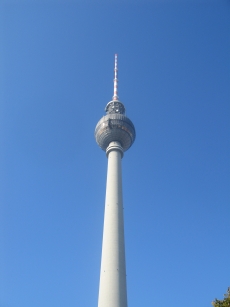
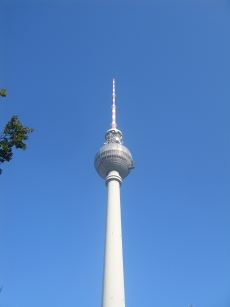
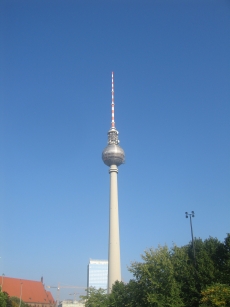
|
The first place we headed was Alexanderplatz, one of the main U-Bahn stations, and closest to one of the most prominent things on the Berlin skyline - the Soviet-era antenna tower. This tower is huge, with a massive base, and a large sphere three-quarters of the way up. It was also vexxing to the Soviets during the cold war - the textured skin on the dome would light up with a bright cross when sunlight shown on it. Crosses don't really please communists, so I wonder how that worked out for the engineers. You can barely see the pattern forming on the bottom picture. |
|
|
|
|
At the base of the tower was a television station, and a large rose garden led to the west, to what I assume is Alexanderplatz, the park. I caught Tracy in a wonderful "blonde moment," as she was trying to figure out her camera in front of the rosebeds. After I took this picture, she noticed Rob and I laughing, and demanded to know what we were laughing about. The rose gardens were quite lovely indeed. |
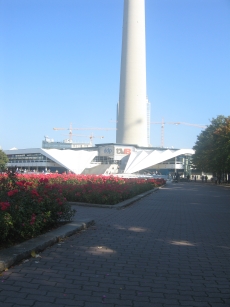
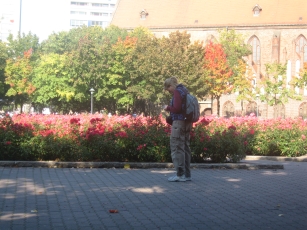
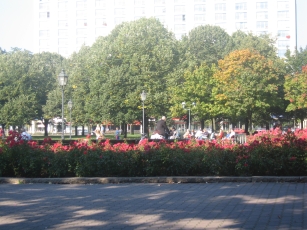
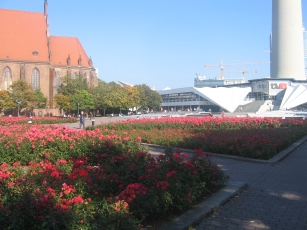
|
|
|
|
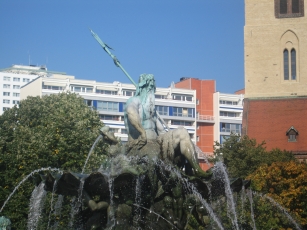
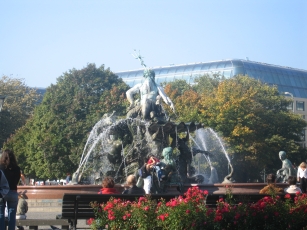
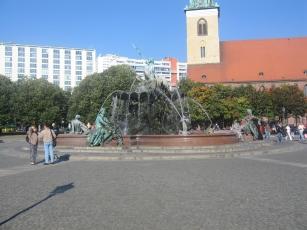
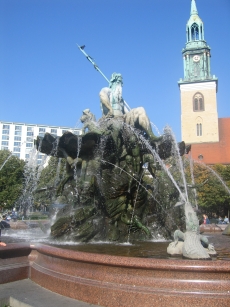
|
At the end of the rose garden opposite the TV tower was a fountain depicting Poseidon, the Greek god of the sea. It was surrounded by four smaller statues at the compass points, and seals and snakes sprayed water on it. |
|
|
|
|
Our next stop was the Rathaus (town hall). It was a beautiful old building with a little street market in front, and a serious-looking German police officer at the door. I didn't reduce the large image of the entrance as much as the others, so you can see the intricate stonework above the great door. |
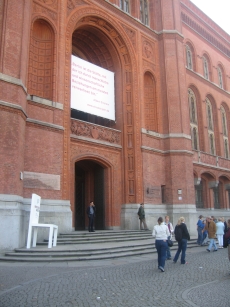
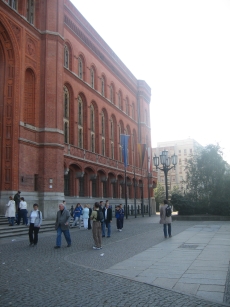
|
|
|
|
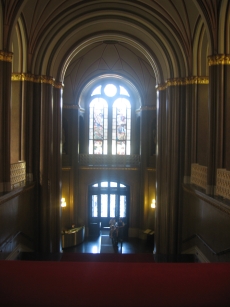
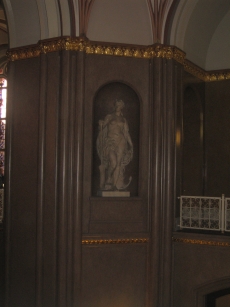
|
These images are just inside the entrace to the Rathaus. The light wasn't real good, and we were told not to use our flashes, so some of the things are kind of hard to see. |
|
|
|
|
On the second floor of the Rathaus was a display of past German politicians and activists. The display cases were very odd - they were approximately eight feet tall, shaped like giant wooden chairs, and were all at odd angles. Here are some closeups of some of the documents - you can clearly see the old Nazi stamps on them. |
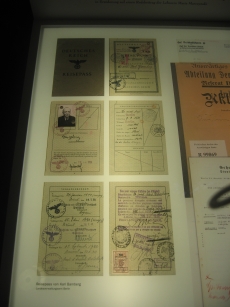
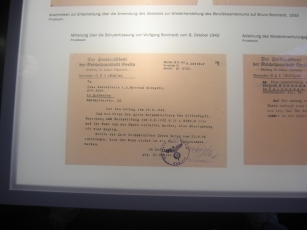
|
|
|
|
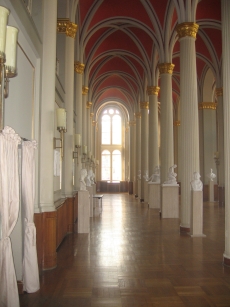
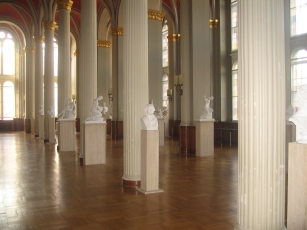
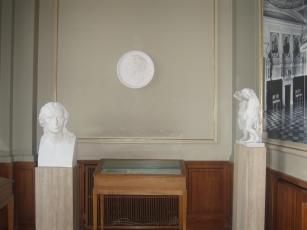
|
Also on the second floor was the Hall of Pillars. This Hall was a long, narrow room with a vaulted ceiling and (surprise!) many, many pillars. There were a large number of busts, sculptures, statues, and plaques, and the best part - we had it all to ourselves! We spent probably twenty minutes looking around and snapping pictures, even though it was about four thousand degrees in the Hall itself. |
|
|
|
|
The ceiling of the Hall of Pillars was gorgeous - you can see it in the first photograph. The color was brilliant, and as always, the workmanship amazed me. At the southern end of the Hall, a statue of two ladies stood in front of a large stained-glass window. It was tough to get a picture of it, since the backlighting kept washing out the statue, but I finally got one that was somewhat good. And finally, several plaques on the wall. |
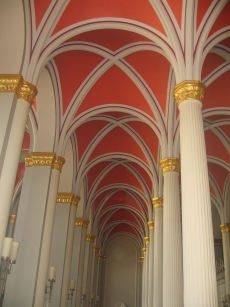
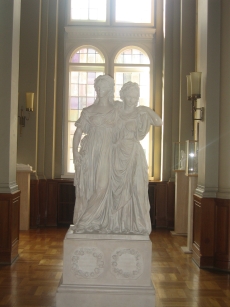
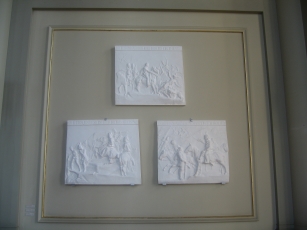
|
|
|
|
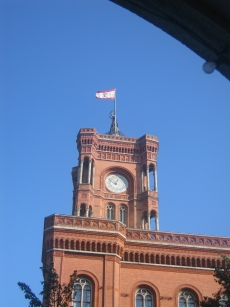
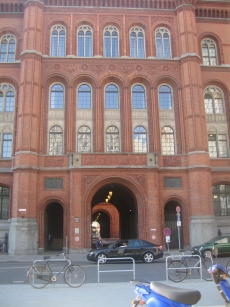
|
We at lunch at a little cafe right across the street. I had a leg of lamb the size of my head, which was fan-freakin-tastic. I also displayed my proficiency at asking for the check (in Europe, they typically don't bring you the bill until you ask, otherwise you'll be sitting there for hours). 'Die Rechnung, bitte' is all it takes. The pictures are of the outside of the Rathaus, as we left the cafe. |
|
|
|
|
After lunch and the Rathaus, we wandered on through the park to the west. There was an open area with several upright metal monuments (or perhaps sculptures). They had photographs printed on them, but I'm still not quite sure what they were all about. In the last two photos, you can see the Berlin Dome in the background. |
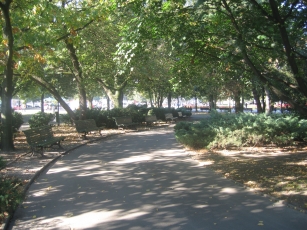
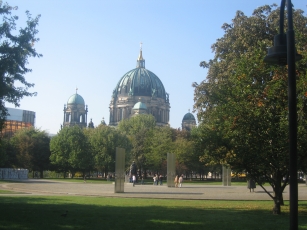
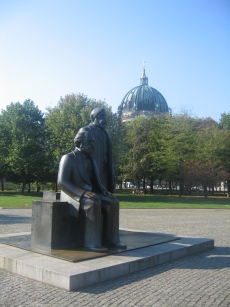
|
|
|
|
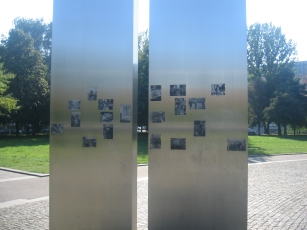
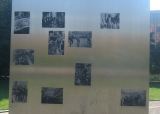
|
These are the metal monuments with photos on them - I'm not sure if you'd call them printings or what. They were perfectly smooth, almost as if the photographs had been exposed directly onto the gleaming stainless steel. |
|
|
|
|
Next, we wandered on towards the Berlin Dome. Along the way, we crossed a canal and passed a most unusual-looking office building. At least I think it was an office building. The first picture is an interesting little open-air atrium lined with shops on both sides. It was bustling with shoppers. In the last photo, you can see the Japanese businessmen and women that we were taking pictures with, more on them on the next page. |
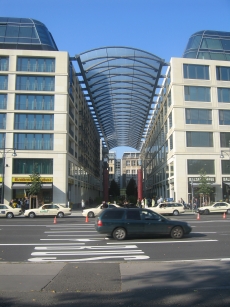
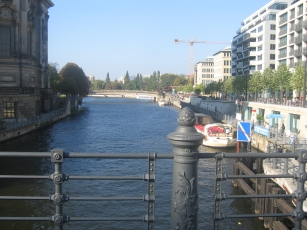
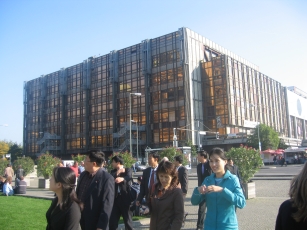
|
|
|
|
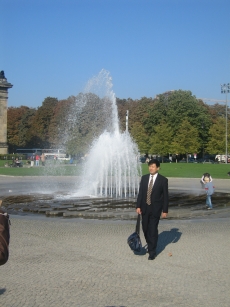
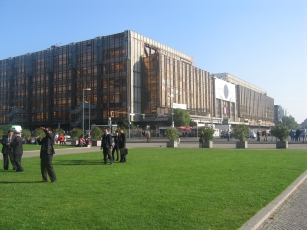
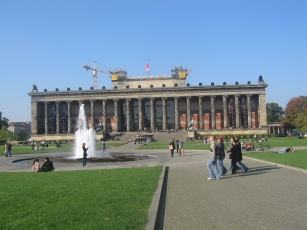
|
Moving on to the Berlin Dome, we came across a very large group of Japanese businessmen and women. They were all over the place, taking pictures of the sights and eachother. They were exceedingly polite, and fun to watch. The Berlin Dome faces a large, open park. To the left of the Dome was a huge museum that had a large Egyptian exhibit going on. |
|
|
|
|
The Berlin Dome is a huge church, situated a little to the west of Alexanderplatz. It has a large dome and a series of smaller ones on towers. The first photo is a normal reduction, while I left the second one full-size (it's big, about 2.5M) so you can see the incredible detail on the building. |
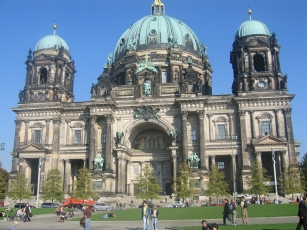

|
|
|
|
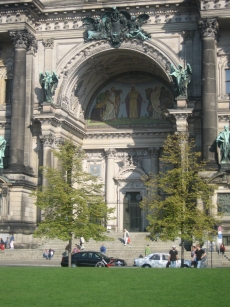
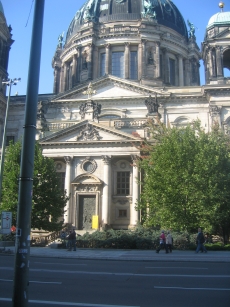
|
The southern entrance was breathtaking. I have left the large image a bit larger than the rest, so you can see the painting. The eastern entrance sported a very cool door, but I didn't get a good shot of it. |
|
|
|
|
Now that we were U-Bahn experts (snork!), we set out for the train station to head down to Checkpoint Charlie and the remains of the Berlin Wall. Along the way, we saw more roses in a small park. And I got Tracy and Rob to ham it up for a picture. |
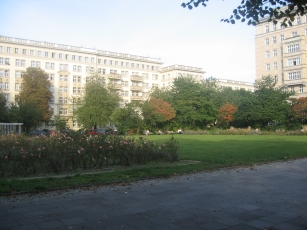
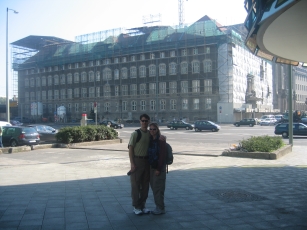
|
|
|
|
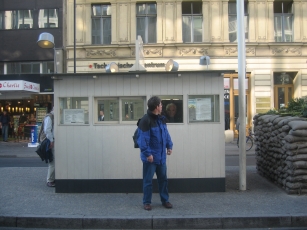
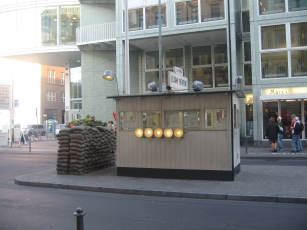
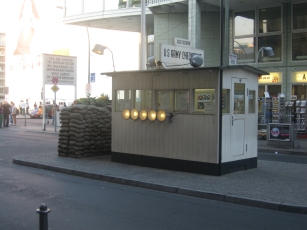
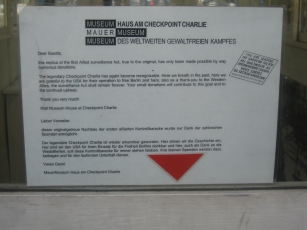
|
During the Cold War, Berlin was divided up into East and West Berlin. The Russians governed East Berlin, and the three Allies (Great Britain, France, and the United States) governed West. The Berlin Wall split the city between the two zones, and was a heavily fortified border between the two. It was a dark time for Berliners - the Wall segregated West Berlin from both East Berlin and East Germany. Access to either was strictly controlled, and 192 people were shot and killed trying to cross the Wall into West Berlin over the years. Another 200+ were seriously wounded. In 1948, the Russians blockaded West Berlin, and the Allies mounted the world's largest rescue operation, Operation Vittles (known as the Berlin Airlift). Ultimately, over the next 320+ days, 278,228 flights carried millions of tons of supplies to the trapped West Berliners. Russia finally backed down on May 11th, 1949, 324 days after it began the blockade. Checkpoint Charlie was one of three Allied checkpoints along the Berlin Wall - Alpha, Bravo, and Charlie. It is easily the most famous. This replica is what remains of the site where it stood. |
|
|
|
|
There was a cafe/museum next to the replica, and in the basement was a huge gallery of childrens' art pieces. Several recurring themes echoed through the halls: unity, peace, and the Wall. |
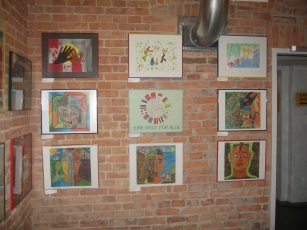
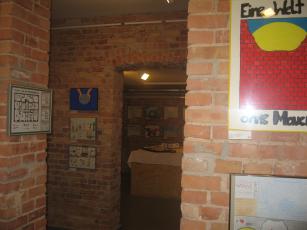
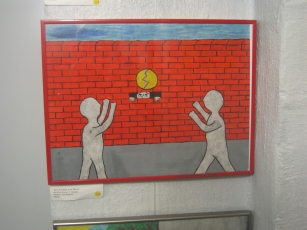
|
|
|
|
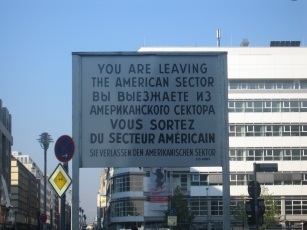
|
This was likely a scary thing to view, as you crossed the Wall into East Berlin. |
|
|
|
|
A block-long section of the Wall stands intact just to the west of Checkpoint Charlie. I wasn't sure how I was going to feel when I finally saw it - after all, this is one very powerful symbol of oppression that I remember very well from my childhood. I remember sitting in my kitchen back home as a kid, and hearing about escape attempts and people getting shot trying. I didn't understand the significance of those events then, but after visiting the Wall, I understand now. Jeezus, do I understand now. There are several large displays at this section of Wall now; one was all in German and I didn't understand much. But the two that I did understand (mostly because they had English translations) were about the trials of Nazis at Nuremburg, and the Topography of Terror. The latter detailed the political prisons that the SS ran in Berlin, and showed many images of the Nazi rise to power, and of the prisons themselves. |
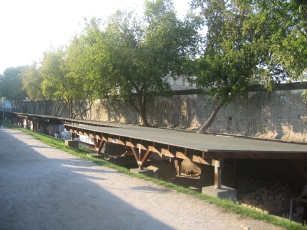
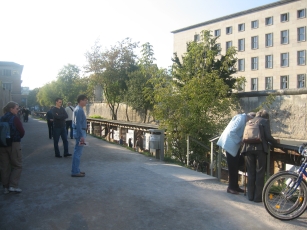
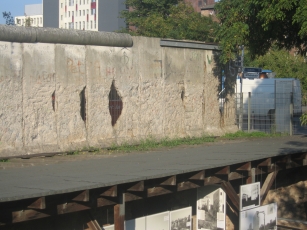
|
|
|
|
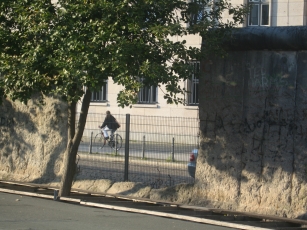
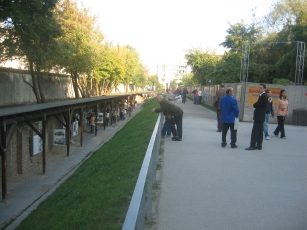
|
Sixteen years ago, that person on the bike would have been in East Berlin. The wall and two of the three displays - the all-German one (below) and the Nuremburg trials one (to the right). |
|
|
|
|
I was deeply affected, seeing the Wall. And it surprised me when the graffiti affected me deeply as well. Until the wall fell in 1989, the graffiti was almost exclusively on the western side, as the heavily armed German guards certainly didn't allow East Berliners to deface the Wall. The Wall separated families and communities, and reading some of the graffiti, I could almost see angry West Berliners scrawling their frustrations in paint on it. These four pictures tell volumes. |
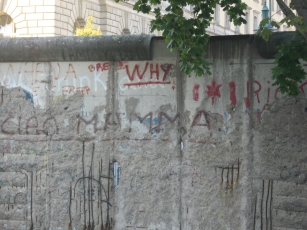
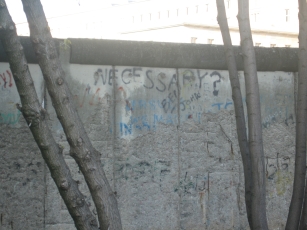
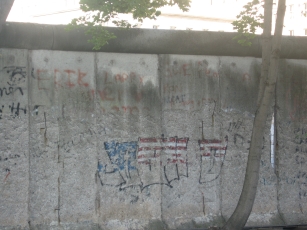
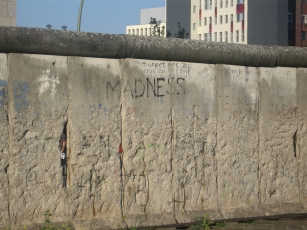
|
| <-- Oct 10 Oct 11th, part II --> | |